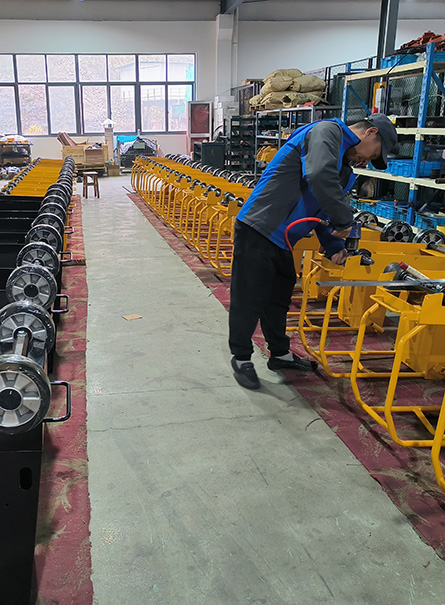The Essence of Power Trowels
Delve into the realm of power trowels, a monumental leap from the conventional manual troweling in concrete craftsmanship. This tool stands at the vanguard of innovation, delivering an impeccably smooth, uniformly level finish to freshly poured concrete. Its role transcends mere aesthetics, ensuring the resultant surface offers optimum comfort for pedestrian traffic.
Mastering the Art of Power Troweling
Harnessing the potential of a power trowel necessitates a blend of skill and precaution. Achieving the zenith of its capabilities involves pouring concrete under the auspices of a cloudless, sun-kissed sky, warding off the perils of rain-induced damage. Initiate the troweling process when your imprints on the concrete are subtle, approximately 1/8" deep - a testament to the readiness of the surface. In the throes of the floating stage, maintain a sedate trowel velocity, coupled with unremitting motion. Eschew the pitfalls of over-troweling; instead, strive for a tapestry of uniform, slightly overlapping strokes.
The Multifaceted Advantages of Power Trowels
Embracing a power trowel in your construction arsenal heralds a myriad of benefits:
- Temporal Mastery: They drastically curtail the duration required for finishing, eclipsing the pace of manual methods.
- Expedited Project Completion: Eradicating the need for manual screeding, these tools are harbingers of swifter project fruition and the capacity to undertake additional ventures.
- Cost-Effectiveness: Power trowels epitomize efficiency in applying finishes, thus economizing on material expenditure.
- Maneuverability: They offer superior ease of navigation compared to their manual counterparts.
- Enhanced Quality of Finish: Typically, power trowels are synonymous with consistency and superior quality in finishing compared to manual techniques.
Choosing the Quintessential Power Trowel Model
The quest for the ideal power trowel model demands discernment:
- Ride-On Models: For instance, the HPT475 Ride On Trowel Machine from Hoppt, boasts features like cruise control, expansive panning paths, elevated rotor velocity, and a safety shutdown controlled by a foot pedal. Designed for prolonged utilization, it comes with a substantial fuel capacity and a potent engine, ensuring maintenance is a straightforward affair.
- Walk-Behind Models: The HPT1002 stands as a paragon, equipped with a robust gearbox, precision-aligned gears, adjustable handles, and a three-year warranty. Its design is tailored for rapid, precise operations in confined spaces.
Navigating the World of Power Trowels
Grasping the essence and utility of a power trowel is merely the inception. As a connoisseur of construction, equipping yourself with the right tools can metamorphose both your efficiency and the caliber of your output. Our extensive gamut of construction tools, inclusive of diverse models of power trowels, cutting and grinding instruments, and indispensable spare parts, is curated to cater to every facet of your construction needs. We invite you to peruse our collection and avail yourselves of our expertise for any additional insights or assistance.
Deciphering Power Trowels: A Contrast Between Walk-Behind and Ride-On Variants
Synopsis of Power Trowels
In the realm of concrete craftsmanship, power trowels stand as pivotal instruments, adept at refining, smoothing, and burnishing surfaces into an epitome of finesse. Manifesting in two distinct breeds - the walk-behind and the ride-on - each variant caters to unique operational demands, making the discernment of their disparities crucial for apt project alignment.
Mechanics of Power Trowels
These contrivances operate in a dual-phase modus: the initial floating phase which involves the harmonization of wet concrete, leveling undulations, and fortifying the substrate. The subsequent burnishing phase orchestrates a sleek, firm veneer atop the slab. For achieving a harmonious finish, it's prudent to execute the trowel's secondary traversal perpendicular to its primary.
Walk-Behind Power Trowels
Manned from the posterior, the walk-behind power trowels are navigated via a handle, featuring a solo rotor arrayed with a trio or quartet of blades, conjuring an image of a fan in motion. Their dimensions oscillate between 24 and 48 inches.
- Optimal Milieus for Walk-Behind Variants
These trowels shine in domains not exceeding 5,000 square feet and more constricted environments. They are adept at intricate operations around structural elements like columns, pipelines, and ingress points, making them apt for domestic basements, flooring, and compact commercial endeavors. Their economic viability and ease of transport render them favorites amongst contractors and small-scale enterprises.
Ride-On Power Trowels
The ride-on type is characterized by a pair of counter-rotating rotors, each armed with four to five blades. The helmsman is stationed centrally, orchestrating the apparatus with steering levers.
- Predicaments Favoring Ride-On Trowels
In scenarios where vast expanses demand brisk and efficient troweling, the ride-on models reign supreme. Boasting augmented horsepower and superior surface compression, they are the go-to for sizable commercial ventures. It's a common sight on extensive projects to witness a synergy of both models: employing ride-on trowels for open stretches and walk-behind versions for more restricted zones.


